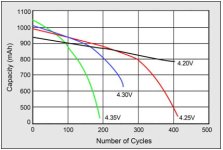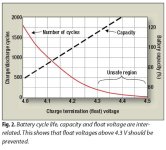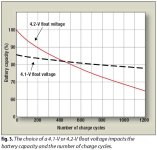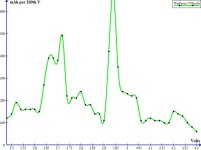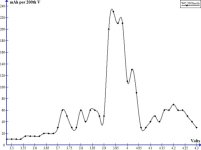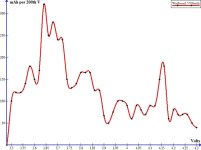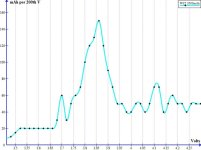DrkAngel
1 GW
Moved from Homemade Battery Packs
Follow the progression or skip towards the newer.
Tests
Boston "Power Swing" 5300
Dell Media Bay LiPo (unbranded)
Samsung ICR18650-22p
Samsung INR18650-R25
Samsung INR18650-29E
Sanyo 18650F
Sanyo 2600mAh (red)
SONY US18650VTC4
Sony Laptop Media Bay LiPo
Thunder Power Extreme 5000mAh
WinForce 5700mAh "20C" RC Lipo
Winners Circle RC Lipo 2000mAh
Lithium Cobalt - Laptop recycled cells
There is some debate and much confusion about optimal charge voltages.
Reputedly, restricting working voltages can greatly prolong-maintain lifespan-capacity.
I have noticed excessive losses in capacity due to .... abuse?
Possible abuses are:
Excessive discharge rates
Excessive charge rates
Excessive charge voltage
Excessive DOD (Depth Of Discharge)
All are potentially damaging!
As with most everything, heat is the enemy!
Lithium is a fairly unique battery technology, at moderate rates, heat production is nearly non-existent.
Anything that produces heat creates "damage"! (Pushes cell beyond "optimal")
As for charge-discharge rates.
I try to limit charges and discharges below .5C, 15Amps from a 30Ah pack.
One thing I noticed is that this .5C should be from the actual present capacity, rather than the original. When the capacity of my 26Ah recycled Laptop Lipo build dropped below 18Ah, I noticed the pack getting warm when charging at 10A. Likewise, standard output, with the diminished capacity, began producing noticeable heat.
Once heat begins being produced during normal use, damage is progressive and accelerated.
Prolonging good capacity is doubly important.
I have decided to test optimal charge and discharge voltages.
As determined by these previously built capacity maps, (See - Capacity Map - By Charge mAh) 3.72V appears to be maximum DOD for the Sanyo 18650's and 3.78V for the Lipo.
These DOD voltages are for a resting voltage, discharge voltages are much lower due to voltage sag.
With cells at max DOD, apply normal throttle discharge.
This will exhibit the max DOD "working voltage".
Sanyo 18650 labeled 3.6V 2600mAh
Lipo labeled 3.7V (2x2160mAh)
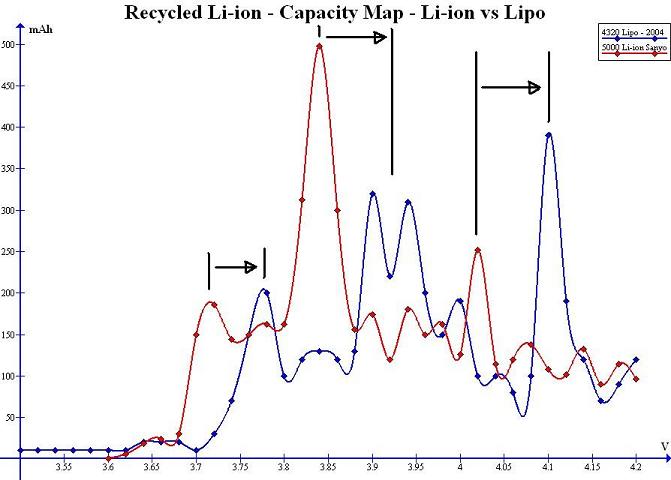
Final factor is optimal charge voltage. Finding the capacity-lifespan saved by lowering charge voltage.
Normally this might take 2 or more identical packs and many months of actual use, to get any measurable results.
To speed up the process I decided to test 3 sets of identical cells at 3 differing charge voltages.
Based on the capacity maps, I decided to use 4.15V, 4.10V and 4.05V.
Tests will be run concurrently with 18650 2600mAh Sanyo and Dell recycled 2160mAh Lipo.
Discharge will be .5C for 1 hour.
Recharge will be with 3 voltage adjusted power supplies.
18650's will be charging while Lipo discharges and vice versa.
All cells will be capacity tested matched and recorded.
I intend on running several cycles per day, 25? per week per each cell, on the side, while I work.
Noticeable results after 50 cycles?
1 hour resultant discharge voltages will be charted for each cycle.
Capacity test will be performed every 50? cycles, and results posted.
Too much work?
Once determined, optimal voltage might double the lifespan of the pack.
Sanyo cells are among the most commonly available and results should be valid and applicable for a multitude of builds.
More importantly, for me, the lipo results will apply nicely to the hundreds of 6 packs I've acquired.
Knowledgeable performance optimization and expectations from many packs, for many years, sounds worth the initial bother.
I do hope others are capable of benefiting also.
Based on capacity map ... ensuring that bulges of capacity are included:
2160mAh Lipo optimal charge voltage is expected to be 4.15V.
2600mAh 18650 Sayno optimal charge voltage is expected to be 4.05V.
This compares reasonably with the iMax charge voltages of 4.2V for "Lipo" and 4.1V for "Li-ion".
Hopefully this might explain the recent rapid deterioration in a Sanyo 18650 build that I have been charging to 4.20V.
Perhaps most enlightening will be the differing results from the Lipo cells at 4.05V and 4.15V.
This voltage difference excludes - includes a substantial bulge of energy capacity!
Preliminary results will be posted as soon as there are any noticeable variations.
Note:
Very likely, DOD is as important, or more important, than charge voltage!
But charge is every cycle, while deep discharge is seldom, or hopefully, never.
Follow the progression or skip towards the newer.
Tests
Boston "Power Swing" 5300
Dell Media Bay LiPo (unbranded)
Samsung ICR18650-22p
Samsung INR18650-R25
Samsung INR18650-29E
Sanyo 18650F
Sanyo 2600mAh (red)
SONY US18650VTC4
Sony Laptop Media Bay LiPo
Thunder Power Extreme 5000mAh
WinForce 5700mAh "20C" RC Lipo
Winners Circle RC Lipo 2000mAh
Lithium Cobalt - Laptop recycled cells
There is some debate and much confusion about optimal charge voltages.
Reputedly, restricting working voltages can greatly prolong-maintain lifespan-capacity.
I have noticed excessive losses in capacity due to .... abuse?
Possible abuses are:
Excessive discharge rates
Excessive charge rates
Excessive charge voltage
Excessive DOD (Depth Of Discharge)
All are potentially damaging!
As with most everything, heat is the enemy!
Lithium is a fairly unique battery technology, at moderate rates, heat production is nearly non-existent.
Anything that produces heat creates "damage"! (Pushes cell beyond "optimal")
As for charge-discharge rates.
I try to limit charges and discharges below .5C, 15Amps from a 30Ah pack.
One thing I noticed is that this .5C should be from the actual present capacity, rather than the original. When the capacity of my 26Ah recycled Laptop Lipo build dropped below 18Ah, I noticed the pack getting warm when charging at 10A. Likewise, standard output, with the diminished capacity, began producing noticeable heat.
Once heat begins being produced during normal use, damage is progressive and accelerated.
Prolonging good capacity is doubly important.
I have decided to test optimal charge and discharge voltages.
As determined by these previously built capacity maps, (See - Capacity Map - By Charge mAh) 3.72V appears to be maximum DOD for the Sanyo 18650's and 3.78V for the Lipo.
These DOD voltages are for a resting voltage, discharge voltages are much lower due to voltage sag.
With cells at max DOD, apply normal throttle discharge.
This will exhibit the max DOD "working voltage".
Sanyo 18650 labeled 3.6V 2600mAh
Lipo labeled 3.7V (2x2160mAh)
Final factor is optimal charge voltage. Finding the capacity-lifespan saved by lowering charge voltage.
Normally this might take 2 or more identical packs and many months of actual use, to get any measurable results.
To speed up the process I decided to test 3 sets of identical cells at 3 differing charge voltages.
Based on the capacity maps, I decided to use 4.15V, 4.10V and 4.05V.
Tests will be run concurrently with 18650 2600mAh Sanyo and Dell recycled 2160mAh Lipo.
Discharge will be .5C for 1 hour.
Recharge will be with 3 voltage adjusted power supplies.
18650's will be charging while Lipo discharges and vice versa.
All cells will be capacity tested matched and recorded.
I intend on running several cycles per day, 25? per week per each cell, on the side, while I work.
Noticeable results after 50 cycles?
1 hour resultant discharge voltages will be charted for each cycle.
Capacity test will be performed every 50? cycles, and results posted.
Too much work?
Once determined, optimal voltage might double the lifespan of the pack.
Sanyo cells are among the most commonly available and results should be valid and applicable for a multitude of builds.
More importantly, for me, the lipo results will apply nicely to the hundreds of 6 packs I've acquired.
Knowledgeable performance optimization and expectations from many packs, for many years, sounds worth the initial bother.
I do hope others are capable of benefiting also.
Based on capacity map ... ensuring that bulges of capacity are included:
2160mAh Lipo optimal charge voltage is expected to be 4.15V.
2600mAh 18650 Sayno optimal charge voltage is expected to be 4.05V.
This compares reasonably with the iMax charge voltages of 4.2V for "Lipo" and 4.1V for "Li-ion".
Hopefully this might explain the recent rapid deterioration in a Sanyo 18650 build that I have been charging to 4.20V.
Perhaps most enlightening will be the differing results from the Lipo cells at 4.05V and 4.15V.
This voltage difference excludes - includes a substantial bulge of energy capacity!
Preliminary results will be posted as soon as there are any noticeable variations.
Note:
Very likely, DOD is as important, or more important, than charge voltage!
But charge is every cycle, while deep discharge is seldom, or hopefully, never.


